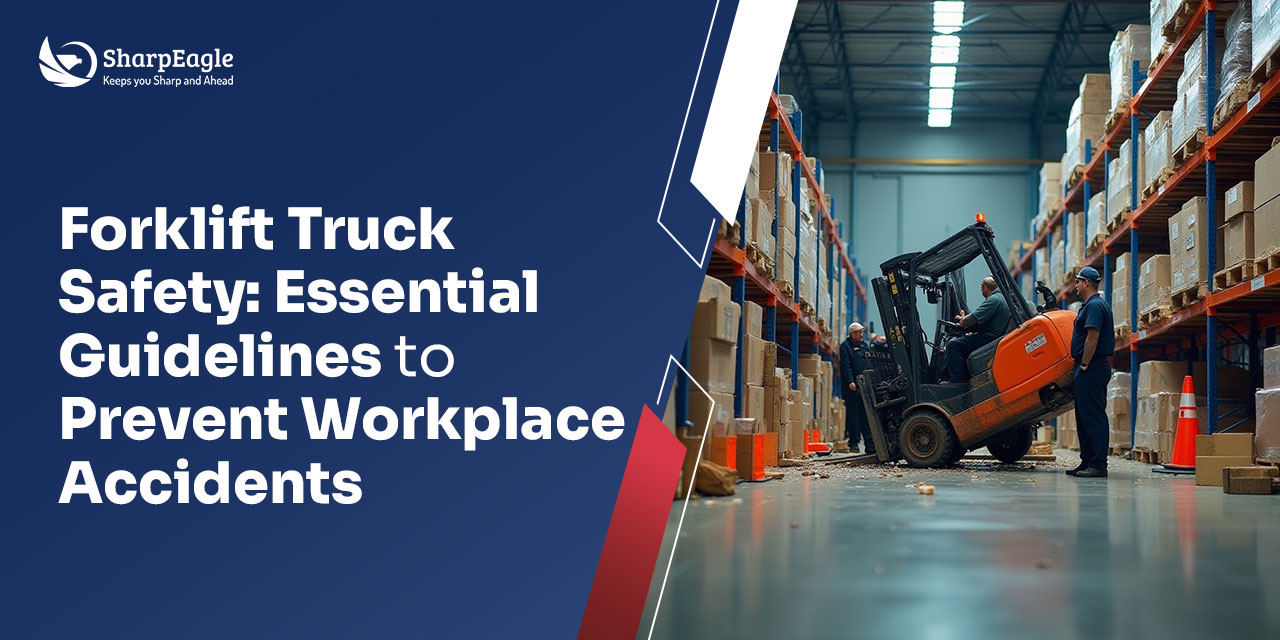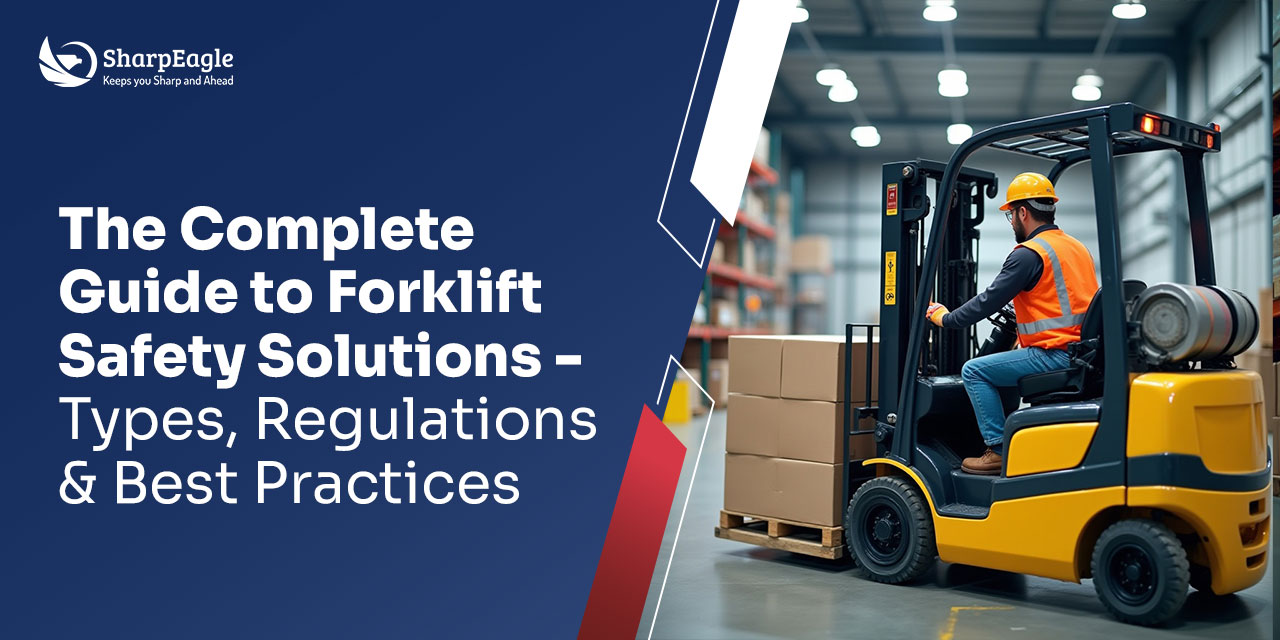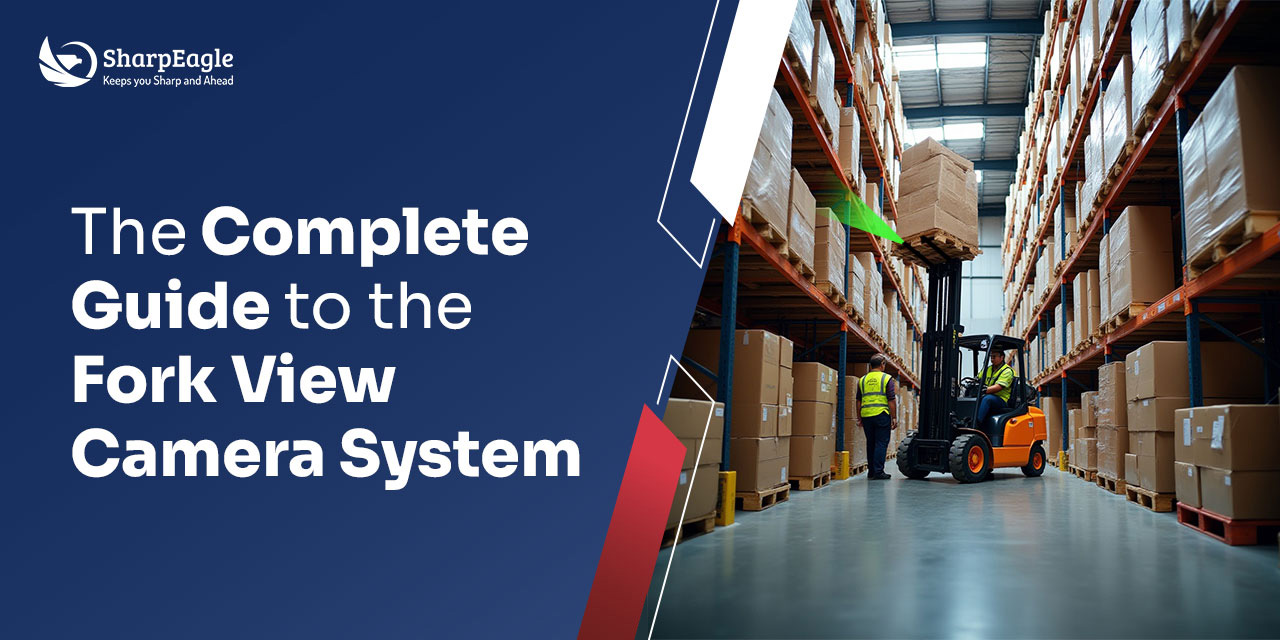
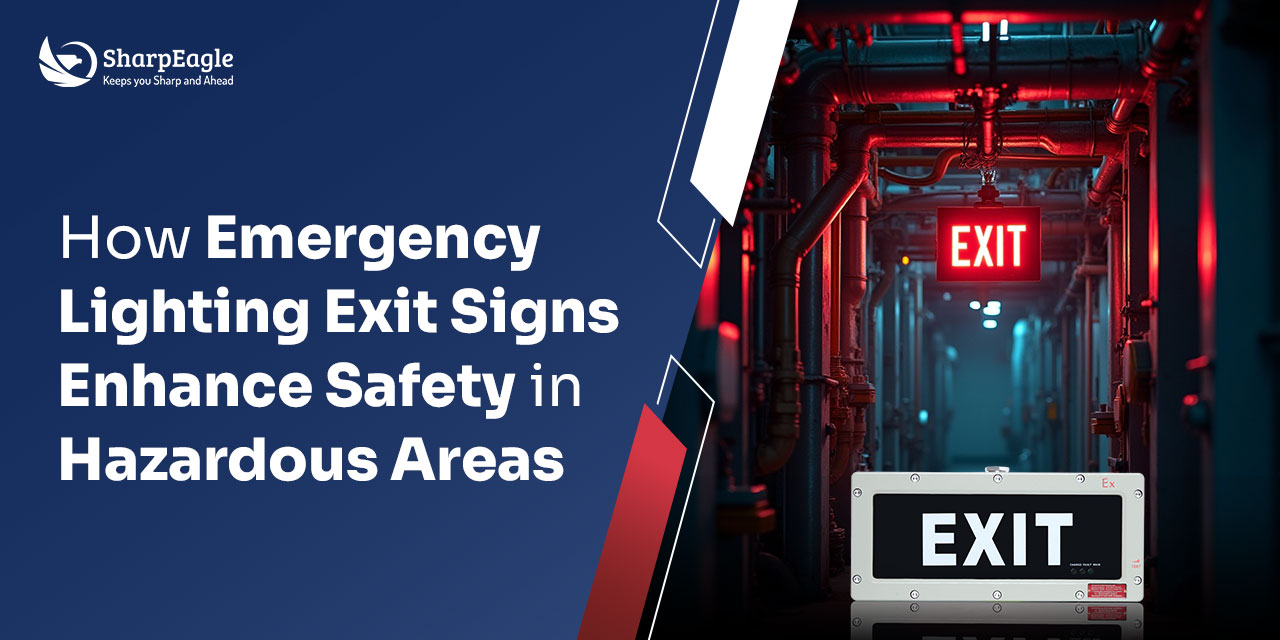
Picture this: you're working the night shift in a chemical processing plant when suddenly the lights go out and alarm sirens pierce the darkness.
In those critical seconds of confusion and potential panic, what's the one thing that could mean the difference between life and death? It's not the fire extinguisher on the wall or the emergency phone by the door - it's those glowing emergency lighting exit signs that transform from barely noticed fixtures into literal beacons of survival.
Have you ever wondered how these life-saving devices continue to function when everything else fails?
Or why some industrial facilities invest thousands of dollars in what might seem like simple "EXIT" signs? The answer lies in understanding that in hazardous areas where explosive gases, flammable vapors, and combustible dust create invisible dangers, ordinary exit signs aren't just inadequate - they're potentially lethal. Let's explore how specialized emergency exit lighting systems become your team's guardian angels in the most dangerous industrial environments.
Think of emergency lighting exit signs as your facility's navigation system during the worst possible moments. But what exactly makes these devices so special, and how do they differ from the basic exit signs you see in office buildings? Imagine trying to find your way out of a maze in complete darkness - that's what an emergency evacuation becomes without proper lighting guidance.
Emergency lighting exit signs are integrated safety systems that combine illuminated directional signage with autonomous power sources, designed to operate independently when primary power fails. But here's where it gets interesting for hazardous areas: these aren't your standard office building exit signs. They're engineered to be explosion-proof, intrinsically safe, and capable of withstanding the harsh conditions that would destroy conventional equipment.
• Illuminated Sign Panel: Weather-resistant, impact-proof housing with clear visibility symbols
• Backup Power System: Battery backup providing 90+ minutes of continuous operation
• Charging Circuit: Automatic battery maintenance and monitoring systems
• Emergency Detection: Sensors that activate during power failures or emergency signals
• Directional Indicators: Arrow configurations showing safe evacuation routes
• Test Systems: Self-diagnostic capabilities ensuring constant readiness
Key Operational Features:
• Automatic activation during power outages or emergency conditions
• Automatic activation during power outages or emergency conditions
• Continuous operation for minimum 90 minutes (often 3+ hours in industrial applications)
• High-contrast visibility in smoke, dust, or low-light conditions
• Weather-resistant construction for outdoor and harsh environment applications
• Intelligent monitoring systems with fault detection and reporting
What transforms an ordinary industrial workspace into a "hazardous area"? The answer might surprise you - it's not always obvious dangers like open flames or visible chemicals. Some of the most dangerous industrial environments look completely normal to the untrained eye. Have you ever walked through a grain elevator, paint booth, or fuel storage area? You might have been surrounded by invisible explosive atmospheres without even knowing it.
Hazardous areas are classified based on scientific analysis of how often explosive atmospheres occur and what types of combustible materials are present. This isn't guesswork - it's based on decades of industrial accident investigation and engineering analysis. Understanding these classifications helps you appreciate why specialized equipment isn't just recommended, it's absolutely critical for survival.

• Hydrocarbon gases and vapors (methane, propane, gasoline vapors)
• Chemical solvents (acetone, toluene, alcohol-based products)
• Combustible dusts (grain, coal, metal powders, pharmaceutical powders)
• Process chemicals (hydrogen, ammonia, various organic compounds)
• Waste gases (biogas, landfill gases, sewage treatment emissions)
Here's a question that might keep you awake at night: what happens when a standard exit sign creates a spark in an atmosphere filled with explosive gas? The answer is catastrophic - we're talking about industrial accidents that make international headlines and change entire industries. Have you ever seen footage of industrial explosions? Those devastating events often start with something as simple as an electrical malfunction in everyday equipment.
Standard exit signs pose multiple ignition risks in hazardous environments. The fluorescent bulbs can create electrical arcs, plastic housings generate static electricity, internal wiring produces sparks during failures, and overheating components reach dangerous temperatures. In a hazardous atmosphere, any one of these seemingly minor issues can trigger an explosion with deadly consequences.
Standard Exit Signs vs. Explosion-Proof Exit Signs:

• Texas City Refinery (2005): Electrical equipment ignition killed 15 people
• West Fertilizer Explosion (2013): Improper electrical systems contributed to massive blast
• Countless near-misses: Documented cases where proper equipment prevented disasters
• Regulatory enforcement: Millions in fines for non-compliant safety systems
• Insurance implications: Coverage denied for facilities using improper equipment
The sobering reality is that using standard electrical equipment in hazardous areas isn't just dangerous - it's often illegal and can void insurance coverage. Specialized explosion proof exit sign isn't an expensive luxury; they're legal requirements and moral imperatives for protecting human life.
What if I told you that investing in proper emergency explosion proof exit light systems could actually save your company money while potentially saving lives? It sounds like a win-win scenario, but how does the math actually work out? Let's break down the tangible and intangible benefits that make these systems one of the smartest safety investments you can make.
The benefits extend far beyond basic compliance - they create a comprehensive safety net that protects your most valuable assets: your people. When you consider the total cost of industrial accidents including legal liability, regulatory fines, insurance claims, operational shutdowns, and reputation damage, the investment in quality emergency lighting systems looks remarkably attractive.
Immediate Protection:
• Reliable evacuation guidance during power outages and emergency conditions
• Panic reduction through clearly visible escape route identification
• Faster evacuation times reducing exposure to developing hazards
• Emergency responder guidance helping rescue teams navigate safely
• Multiple backup systems ensuring functionality even during equipment failures
Long-term Safety Culture:
• Employee confidence in workplace safety systems and emergency preparedness
• Training effectiveness using actual installed systems for evacuation drills
• Incident prevention through improved hazard awareness and visibility
• Emergency preparedness supporting comprehensive safety management systems

• Reduced inspection downtime through self-monitoring capabilities
• Lower maintenance costs with long-life LED technology and robust construction
• Improved worker morale through visible commitment to safety
• Enhanced emergency response with reliable guidance systems
• Regulatory confidence demonstrating proactive safety management
Navigating the maze of safety regulations can feel overwhelming, can't it? With acronyms like ATEX, IECEx, NFPA, and OSHA floating around, how do you know which standards apply to your specific situation? And what happens if you get it wrong? The consequences of non-compliance aren't just financial penalties - they can include criminal liability if accidents occur due to inadequate safety systems.
Understanding regulatory requirements isn't just about checking boxes for compliance officers. These standards represent decades of engineering expertise and lessons learned from tragic industrial accidents. Every requirement has a purpose, often written in the blood of workers who didn't have proper protection.
Major International Standards:
ATEX Directive (Europe):
• Equipment Directive 2014/34/EU covering equipment design and manufacturing
• Workplace Directive 1999/92/EC addressing employer obligations and workplace safety
• Harmonized standards (EN 60079 series) providing technical specifications
• Conformity assessment requiring third-party certification and ongoing compliance
• CE marking requirements demonstrating regulatory compliance
IECEx System (International):
• IEC 60079 standards providing globally recognized technical requirements
• Certificate of Conformity (CoC) enabling international equipment acceptance
• Quality Assessment (QAR) ensuring manufacturing consistency and quality
• Mutual recognition streamlining certification across participating countries

• Hazard assessment identifying explosive atmosphere locations and characteristics
• Equipment selection matching certified devices to specific zone requirements
• Installation standards following manufacturer specifications and code requirements
• Documentation maintenance keeping certificates, manuals, and inspection records current
• Regular inspection ensuring continued compliance and proper operation
• Training programs educating personnel on proper use and emergency procedures
The key insight here is that compliance isn't a one-time activity - it's an ongoing responsibility requiring systematic attention and regular updates as standards evolve and facilities change.
Selecting emergency explosion proof led exit sign for hazardous areas feels a bit like choosing safety equipment for astronauts, doesn't it? The stakes are incredibly high, the environment is unforgiving, and there's absolutely no room for error. But where do you even begin when every specification seems critical and every vendor claims their products are the best?
The selection process requires balancing technical requirements, regulatory compliance, environmental conditions, and practical operational needs. Let me walk you through a systematic approach that takes the guesswork out of this life-critical decision. Think of it as your personal guide through the technical maze.
Hazardous Area Analysis:
• What zone classification applies to your installation locations?
• What types of explosive substances are present (gases, vapors, dusts)?
• What are the specific gas groups or dust characteristics?
• What temperature ranges will the equipment experience?
• Are there corrosive chemicals or harsh environmental conditions?
Operational Requirements:
• How many exits require emergency lighting coverage?
• What are the viewing distances and angles for visibility?
• Do you need self-contained or centrally powered systems?
• What backup power duration is required (90 minutes minimum, often 3+ hours)?
• Are there specific mounting or installation constraints?
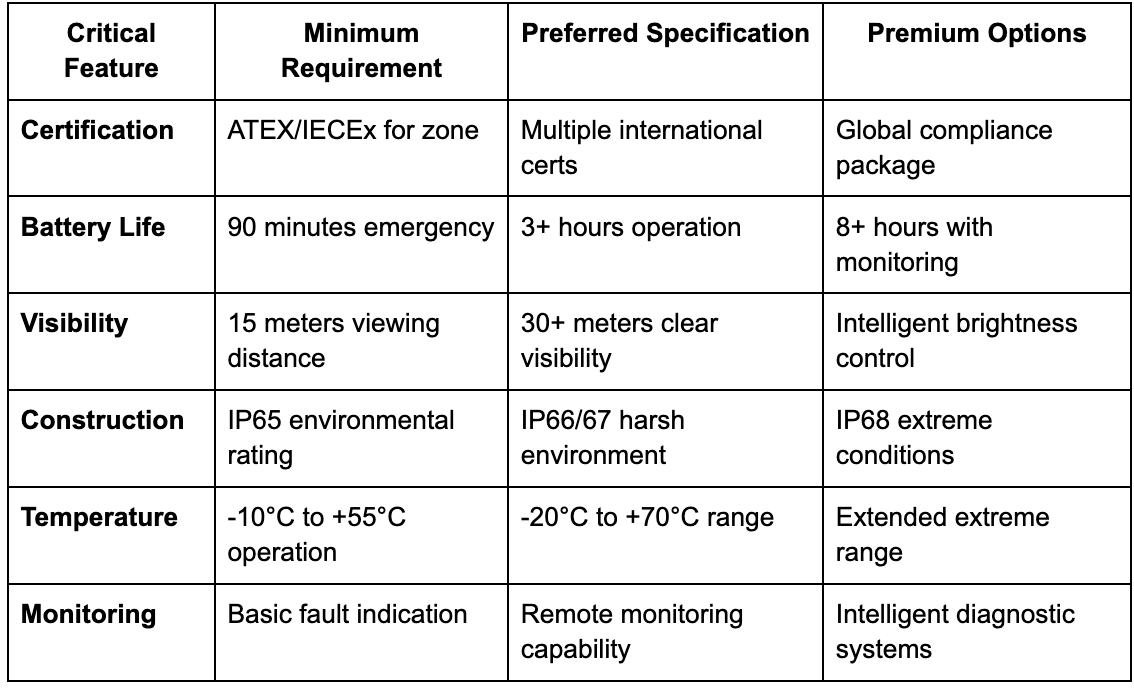
Essential Vendor Qualifications:
• Certification expertise with documented experience in your industry and region
• Technical support including design assistance, installation guidance, and troubleshooting
• Quality manufacturing with ISO certification and consistent product performance
• Local presence providing accessible service and support when you need it
• Training programs ensuring your team understands proper installation and maintenance
Red Flags to Avoid:
• Vendors who can't provide complete certification documentation
• Products claiming "equivalent to" certified standards without actual certification
• Unusually low pricing that suggests compromised quality or compliance
• Limited technical support or unclear warranty terms
• No local service presence or inadequate spare parts inventory
Investment Components:
• Initial equipment cost including signs, mounting hardware, and accessories
• Installation expenses covering professional setup and system commissioning
• Training costs for maintenance personnel and end users
• Ongoing maintenance including battery replacement and system testing
• Certification maintenance ensuring continued compliance and updates
Cost-Benefit Calculation: Consider the total investment against potential consequences of inadequate systems. Factor in avoided regulatory fines, reduced insurance premiums, prevented business interruption, and the immeasurable value of worker safety and life protection.
Installing emergency lighting exit signs in hazardous areas isn't like hanging a picture on your office wall, is it? Every connection, every mounting decision, and every maintenance action must be performed with the understanding that lives depend on getting it right. Have you ever wondered what separates a proper installation from a disaster waiting to happen? The answer lies in following proven best practices developed through decades of industrial safety experience.
The installation and maintenance of these critical safety systems require specialized knowledge, proper tools, and unwavering attention to detail. Let's explore the professional practices that ensure your investment in safety equipment actually delivers the protection you're counting on when lives are on the line.
Pre-Installation Planning:
• Site survey and hazard assessment confirming zone classifications and environmental conditions
• Electrical system analysis ensuring compatibility with existing infrastructure and emergency power systems
• Evacuation route optimization positioning signs for maximum effectiveness during emergencies
• Regulatory compliance review verifying installation meets all applicable codes and standards
• Coordination with other trades integrating with fire alarm, security, and building management systems
Installation Best Practices:
• Certified electricians only - hazardous area electrical work requires specialized training and certification
• Proper grounding and bonding preventing static electricity buildup and ensuring electrical safety
• Explosion-proof connections using only approved fittings, conduits, and termination methods
• Environmental sealing protecting against moisture, dust, and chemical exposure
• Proper mounting height and angles ensuring optimal visibility during normal and emergency conditions

Critical Maintenance Procedures:
• Only use certified replacement parts maintaining explosion-proof integrity and certification validity
• Follow manufacturer procedures exactly ensuring warranty coverage and safety compliance
• Document all maintenance activities supporting regulatory compliance and insurance requirements
• Train maintenance personnel properly preventing accidents and ensuring effective service
• Maintain spare parts inventory ensuring rapid repair capability for critical safety systems
Dangerous Errors:
• Using non-certified components or substituting "equivalent" parts without proper approval
• Inadequate mounting allowing vibration or impact damage in industrial environments
• Poor cable management creating potential ignition sources or maintenance hazards
• Incorrect zone classification leading to improper equipment selection
• Insufficient testing failing to verify proper operation before system commissioning
Quality Assurance Steps:
• Professional commissioning with complete system testing and documentation
• Training delivery ensuring facility personnel understand operation and basic maintenance
• Documentation package including certifications, manuals, warranty information, and maintenance schedules
• Performance verification confirming installation meets design specifications and regulatory requirements
What does the future hold for emergency lighting technology in hazardous areas? Are we approaching revolutionary changes that will transform how these life-saving systems operate, or will safety constraints always limit innovation? The exciting answer is that we're witnessing a convergence of multiple technology trends that promise to make emergency lighting systems smarter, more reliable, and more effective than ever before.
The intersection of LED technology, wireless communications, artificial intelligence, and advanced materials science is creating unprecedented opportunities for innovation while maintaining the uncompromising safety standards required for hazardous area applications.
Smart Integration Capabilities:
• IoT connectivity enabling real-time monitoring and predictive maintenance
• Wireless mesh networking creating comprehensive facility-wide emergency guidance systems
• AI-powered diagnostics predicting failures before they occur and optimizing maintenance schedules
• Integration with building systems coordinating with fire alarms, security systems, and evacuation management
• Mobile app interfaces allowing remote monitoring and management by facility personnel
Advanced LED Technology:
• Ultra-long life spans reducing maintenance requirements and increasing reliability
• Intelligent brightness control adapting to ambient conditions and emergency situations
• Spectrum optimization improving visibility in smoke, dust, and adverse conditions
• Energy efficiency improvements extending battery life and reducing power consumption
• Smart color systems using different colors to indicate evacuation routes vs. shelter areas
Emerging Safety Features:
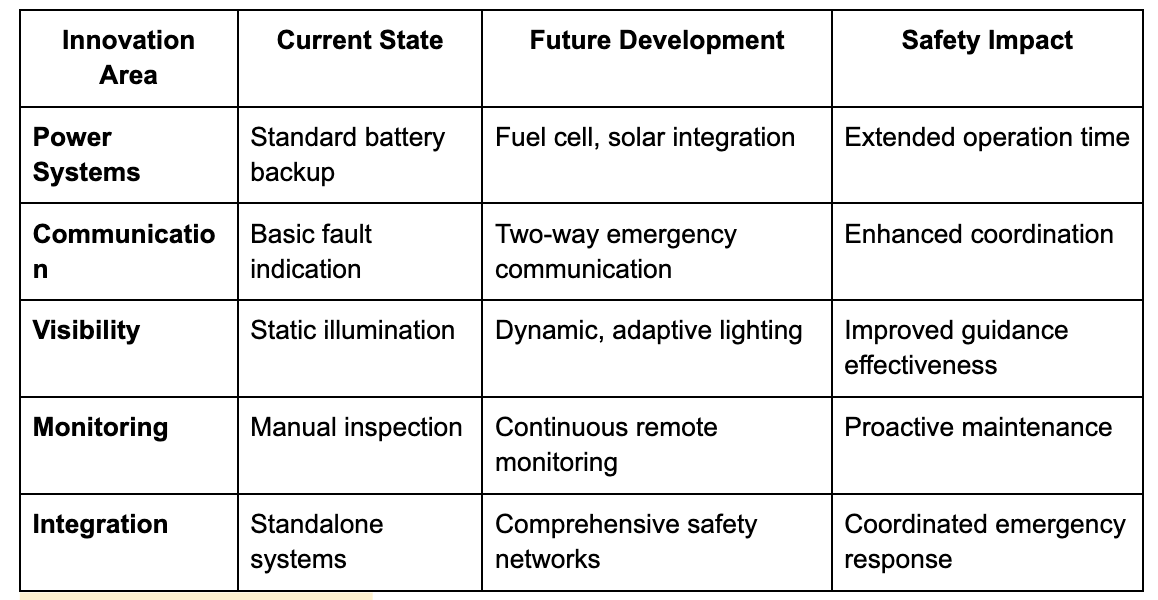
Next-Generation Features:
• Voice guidance systems providing audible evacuation instructions in multiple languages
• Augmented reality integration overlaying digital evacuation information on smart devices
• Environmental sensors detecting smoke, gas, or other hazards and adapting guidance accordingly
• Crowd management algorithms optimizing evacuation routes based on real-time occupancy
• Emergency responder integration providing tactical information to firefighters and rescue teams
Regulatory Evolution: The regulatory landscape is evolving to embrace new technologies while maintaining strict safety standards. Future standards will likely address IoT security, wireless reliability, and integration requirements while preserving the fundamental explosion-proof and intrinsically safe principles that protect lives.
When your team's safety depends on equipment performing flawlessly in life-threatening situations, why would you trust anything less than proven excellence? At SharpEagle Technology, we don't just manufacture emergency lighting equipment - we engineer peace of mind for some of the world's most dangerous industrial environments. But what sets us apart in a crowded marketplace of safety equipment suppliers?
Our commitment goes beyond simply meeting minimum standards. We understand that when the lights go out and alarms sound, our equipment becomes the difference between chaos and organized evacuation, between tragedy and everyone going home safely to their families. This understanding drives everything we do, from initial design concepts through ongoing customer support.
Advanced LED Emergency Lighting Systems:
• ATEX and IECEx certified for global hazardous area applications
• Extended battery life providing 3+ hours of continuous emergency operation
• Robust construction with IP67 rating for extreme industrial environments
• Temperature resilience operating reliably from -30°C to +70°C
• Intelligent monitoring with self-diagnostic capabilities and fault reporting
• Multiple mounting options for versatile installation in any industrial setting
Professional Exit Sign Boards:
• High-visibility LED technology ensuring clear guidance in smoke, dust, or low-light conditions
• Explosion-proof housing meeting strictest safety standards for Zone 0/1/2 applications
• Universal pictogram compliance meeting international evacuation signage requirements
• Weather-resistant design for indoor and outdoor hazardous area installations
• Maintenance-friendly access enabling quick battery replacement and system testing
• Customizable configurations including directional arrows and multi-language options
Engineering Excellence:
• In-house design and testing ensuring every product meets our exacting standards
• Continuous innovation incorporating latest technology within safety constraints
• Quality manufacturing with ISO-certified processes and rigorous testing protocols
• Global certification supporting international projects and multi-regional operations
Customer-Focused Service:
• Technical consultation helping you select optimal solutions for specific applications
• Installation support providing guidance and training for proper system implementation
• Comprehensive training programs ensuring your team maximizes equipment effectiveness
• Responsive customer service with local support presence and rapid response times
• Long-term partnership supporting your safety needs through equipment lifecycle and beyond
Our emergency lighting solutions protect workers in oil refineries across the Middle East, chemical plants throughout Europe, mining operations in Australia, and pharmaceutical facilities in Saudi Arabia. This global trust reflects our unwavering commitment to quality, reliability, and safety performance.
As we conclude our journey through the critical world of emergency lighting exit signs for hazardous areas, I hope you now understand these systems for what they truly are - sophisticated life-protection technologies that stand ready to guide your team to safety when everything else fails. From the moment power fails to the last person evacuating safely, these systems serve as silent guardians watching over your most valuable assets: your people.
The investment in quality explosion proof emergency lighting systems represents more than regulatory compliance or risk management - it demonstrates your organization's fundamental commitment to worker safety and operational excellence. In hazardous industrial environments where invisible dangers lurk around every corner, proper emergency lighting isn't just recommended equipment; it's a moral imperative and legal requirement.
Remember that in emergency situations, there are no second chances to get safety right. The decisions you make today about emergency lighting systems will determine whether your team can evacuate safely when disaster strikes. Choose equipment that meets the highest standards, work with experienced suppliers, and never compromise on the safety systems that protect human life.
Don't leave your team's safety to chance with inadequate emergency lighting systems. Your workers deserve the peace of mind that comes from knowing they can find their way to safety, even in the worst possible circumstances. At SharpEagle Technology, we're ready to help you create a comprehensive emergency lighting solution that protects your people while meeting all regulatory requirements.
Our team of certified safety experts is standing by to assess your facility's specific needs and recommend the optimal emergency lighting configuration for your hazardous areas. We'll conduct a thorough site evaluation, analyze your evacuation routes, and design a system that provides reliable protection for years to come.
Take action today:
Your team's safety is our priority. Contact SharpEagle Technology now and discover how our proven emergency lighting solutions can enhance your facility's safety while ensuring full regulatory compliance. Because when seconds count and visibility is critical, you need emergency lighting systems you can trust completely.
How do emergency lighting exit signs function during power outages or emergencies?
Great question! Emergency lighting exit signs are designed with sophisticated backup power systems that automatically activate the moment primary power fails. Here's how the magic happens: these systems continuously monitor your facility's electrical supply, and when they detect a power outage, they instantly switch to internal battery power without any interruption in lighting.
Are emergency exit signs mandatory in hazardous industrial environments?
Absolutely, and the requirements are even more stringent than in regular commercial buildings! In hazardous industrial environments, emergency exit light systems aren't just recommended - they're legally mandated by multiple layers of regulation. OSHA requires adequate emergency lighting for safe evacuation in all workplaces, but hazardous areas have additional requirements under NFPA codes and other industry-specific standards.
How do emergency exit signs enhance worker safety in oil, gas, and chemical plants?
In oil, gas, and chemical facilities, emergency exit signs serve as the critical link between workers and survival during catastrophic events. Think about the unique challenges these environments present: sudden releases of toxic gases that can disorient workers, explosive atmospheres where a single spark could trigger massive explosions, complex facility layouts where wrong turns can lead to dead ends, and smoke or vapor clouds that reduce visibility to zero.
Can emergency exit signs be customized for specific hazardous area requirements?
Definitely! One size absolutely does not fit all when it comes to emergency lighting in hazardous areas, and reputable manufacturers like SharpEagle offer extensive customization options to meet your specific operational needs. Customization options typically include zone-specific certifications ensuring compliance with your exact hazardous area classification, multiple mounting configurations for walls, ceilings, or specialized industrial structures.
What type of maintenance is required for emergency lighting exit signs?
Proper maintenance of emergency lighting exit signs is crucial for ensuring they'll work when lives depend on them, and the good news is that modern LED systems require much less maintenance than older technologies. Your maintenance program should include monthly visual inspections checking for physical damage, proper illumination, and clear visibility of exit symbols and directional arrows. Monthly function testing involves activating emergency mode to verify proper operation and timing battery backup duration.
